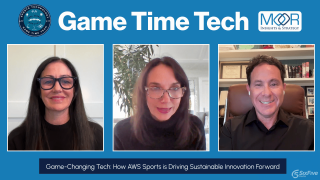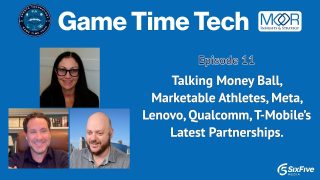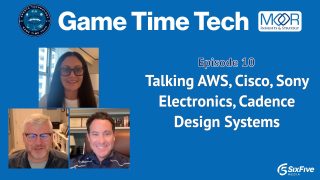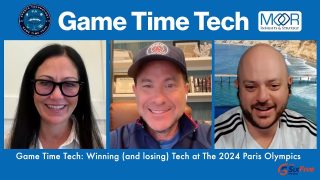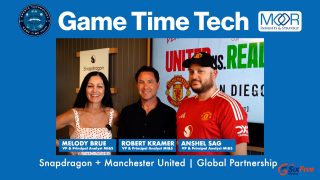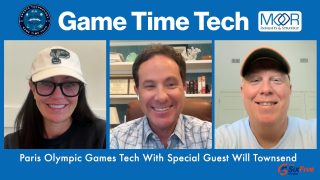On this episode of the Six Five – Game Time Tech, hosts Melody Brue and Robert Kramer are joined by IBM’s VP of Sports and Entertainment Partnerships, Noah Syken, to discuss IBM’s role in the tech on display at the 2024 US Open Tennis Championships. This year debuts the power of generative AI to add spoken commentary to match highlights, produce match previews, and write hundreds of match summaries called “Match Reports.”
Their discussion covers:
- IBM’s 30+ years of innovation in their partnership with the USTA to revolutionize the digital experience of the 2024 US Open Tennis Championships
- IBM’s collaboration expanding the tournament’s online presence, engaging millions of fans worldwide via USOpen.org and the US Open app
- Expert insights on how tech and generative AI enhance the tournament experience
Learn more at IBM and the US Open.
Watch the video below, and be sure to subscribe to our YouTube channel, so you never miss an episode.
Or listen to the audio here:
Disclaimer: The Six Five Webcast – Game Time Tech is for information and entertainment purposes only. Over the course of this webcast, we may talk about companies that are publicly traded and we may even reference that fact and their equity share price, but please do not take anything that we say as a recommendation about what you should do with your investment dollars. We are not investment advisors, and we ask that you do not treat us as such.
Transcript:
Robert Kramer: Welcome to this week’s edition of Moor Insights & Strategy Game Time Tech. What’s very interesting is we’re actually on episode nine now, Mel. So Melody Brue and Robert Kramer, both VPs and Principal Analysts here. And we’re at a special day today. We’re going to be talking about the US Open, and Sports Technology, with Noah Syken. And he’s the VP of Sports & Entertainment at IBM Partnerships. Mel, what do you think? We were just there. How was it?
Melody Brue: It was so great. It was really fantastic. And I feel very fortunate and very spoiled that I was at Wimbledon this year, and then the US Open. And different experiences, but both really cool. And I feel like it was, got to experience, I think, one, both events, but also, we both had a similar experience of being able to be in the IBM suite, and have this really great experience with Tracy Austin there and all of that. But then also, just being able to walk around the grounds, experience what everybody experiences when they’re there. Use the app to find our way around. Get the scores, find out. I think one of my actual favorite memories was when we were just walking around, and we heard all that cheering on court 12. And being able to just pull up the app, and see who’s playing on court 12, and see that they were going into overtime.
Or it’s not overtime, what, a tiebreaker. Wrong sport. Going into a tiebreaker and walking over to see that. So having the app on site is definitely really useful for those things. But then, when I went home, I continued to use the app to find who’s playing, what the standings were, where I could watch it, where it was playing, and all of that. I don’t know, I thought it was really great. What was your experience?
Robert Kramer: The app is one of those things where, as we evolve through the years and technology’s involved, it gives us so much more information. So like you said, it gave us some key information to go to that court 12. But what I really liked about it is, it gave us the schedules, it gave us our tickets, which is pretty cool how it was actually integrated with Ticketmaster. And then you could actually download your tickets. You had your tickets, you had the schedule, you had the match plays, you had the summaries, the stats, who’s going to win.
And then when I got home I was using it. It gave us a lot of information about players I didn’t know about, because, obviously, there’s a ton of players, tons of matches. And I think it’s a really unique app to have. And it was special. When you were at Wimbledon, which is really interesting, because you take the nostalgia of Wimbledon, and you have the interesting fan dynamic at US Open, and then you have the technology. Did the technology make the experience better at both? And then if it did, which I’m sure it did, which one did you feel was more interesting to you, and exciting?
Melody Brue: So I used the US Open app a lot more than I used the Wimbledon app. And I think it’s because of how complex it is with, there’s the transportation. Same thing with the tickets at Wimbledon, it was on the app. But it’s such a long tournament, and the number of matches, and the number of match, what do they call them? The match reports. Even just the transportation getting there, then the different places to eat. There’s just a lot more to it than there was at Wimbledon, where you can just walk around and see everything. It’s all right, a little bit more condensed. But one of the things I thought with these match reports, that with using generative AI to do that, is it really gives more personalized insights on a more granular level. Because previously, you have these reporters, basically, who can only do matches for, or only do these reports for a certain number of matches.
So if you have a player on, let’s say, court 12, you may not be able to get a report for that match, but that might be the player that you’re there to see. So with AI being able to generate these reports, they’re not just completely generating the report, they’re basically giving the basics. And then these reporters are going in and they’re filling in the rest of all of the details, and they’re adding in what they saw. And so I think it’s a very interesting use case of the potential of AI to augment productivity and output, but it still has that human involvement. And I think that really, that does remain really critical for ensuring that accuracy and quality. So I think that part was interesting to me. But in terms, to answer your question about the app, I think the Wimbledon app was really beautiful. The US Open app, there was a lot more to it. But like the Masters app, the Wimbledon app was just so… The user experience was quite lovely.
Robert Kramer: Interesting. But one of the things, remember you mentioned Tracy Austin, and Tracy was giving us a presentation before, and she was talking about the different players. And Watsonx aggregated a lot of data about the two players. And it talked about what one of the players does, and the way the person hits it. And we were like, that’s interesting. And then we actually went and watched the match, and it was exactly that.
Melody Brue: Yeah, yeah.
Robert Kramer: So AI is playing a role in grabbing a lot of this, like you were talking about, it takes all this different information. It’s not so black and white. If it was, they wouldn’t need AI. It would be the human being able to discern all that information and decide what they want to use from a predictability perspective. But this is way more complex. And it’s needed. And they’ve trained these models for years to be able to aggregate all this information to make these predictions, because it’s fantastic. And Noah, who will be joining us in just a few minutes, will elaborate on how that actually happens.
Melody Brue: All right, well let’s welcome Noah. The US Open just wrapped up. We were there. It was great. A girlfriend of mine said that the Flushing Meadows is just a vibe. And I was like, “Huh? What does that mean?” Now I know what it means. There were definitely some vibes there. But for IBM, for you, how did it go?
Noah Syken: It went great. It’s almost a three-week event now. And fans love the US Open. They love tennis. I think they reached over a million visitors this year, a record. And we saw more people come out than ever. And frankly, we had more demand for folks to come out than ever. People continue to consume content in all ways around the US Open, and there were some great match-ups with Americans making it to the finals. So I think it was a fantastic Open all around.
Melody Brue: That’s awesome. Yeah, we saw there were a lot of celebrities, a lot of former tennis players. You guys had both Tracy Austin and Andre Agassi in your suite. What do you think it means to those players to see this kind of change in technology? It’s such a massive shift from when they were playing, to now. How does it change for both the fans and the players when there’s just this major shift?
Noah Syken: Sure. From a fan perspective, certainly it gives fans more access to information and content that they’ve ever had before. They’re able to follow their favorite players. If you’re from a particular country, as an example, you have more ability to follow a player that might be a country from your country than you’ve ever had before, more flexibility to follow those types of players. So from a fan perspective, there’s just a greater ability to engage. And from a player perspective, I don’t know if anybody noticed, but the coaches’ boxes now have tablets in them with all kinds of video and data access right at their fingertips. And so we see and hear from those coaches, that this is the kind of information that they’re increasingly using.
Now, different players actually embrace data and information in different consumption patterns. But across the board, when you’re able to slice and dice the data, slice and dice the video, I think the coaches and players are saying, “How do I tap into that more? How do I learn more from that information?” And we’re actually seeing and having some conversations about how AI can play an increased role in getting that information to the right coach or player as quickly as possible.
Robert Kramer: Yeah, Mel and I were actually there as she alluded to. And it was interesting, I utilized the app a ton. Like you just said, it gave us the ability to take a look at some of these players, because there were upsets. And some of these players were from foreign countries we weren’t aware of. It really gave us a lot of information. But you go back to the technology, and the IBM technologies that’s being used, specifically like you mentioned, AI and the Granite models. And how are they trained for this sport? And how far back did it go to make that happen?
Noah Syken: Yeah, so I think we consumed about 7 million data points to create some new value for the USTA this year. And the key is really being able to understand the terminology, the jargon of the domain. And in this case, it’s particularly tennis, right? Passing shots, ACEs. The players, actually, some of the names are kind of challenging sometimes. In golf, it may be the particular jargon of the Masters, the front nine, the back nine, patrons instead of fans. And so tuning the models to the task is really, really important. And Granite, the Granite model in particular, is very domain specific.
So we tuned it to this particular domain. At the US Open, we created match reports, using Watsonx, using the Granite model. So every single match at the US Open, we enabled the USTA staff with a head start of storytelling. So every match we would produce a match report. And I think over the course of just the first day, I think, last year they produced, I think 24 match reports. This year they were able to produce 60 match reports in half the time. So they’re able to actually create more content more quickly, tuned to the task with these models, and using the language that tennis fans come to expect.
Robert Kramer: Was that from the code assistant that was able to do that?
Noah Syken: Well, the code assistant was actually in a different capability to actually help build the digital platforms themselves. So the models were tuned to the task of creating the content, where the code assistant was building the foundation of the platform from the ground up.
Robert Kramer: Gotcha.
Melody Brue: One of the examples that we saw of that was the word Ash. So Arthur Ash Stadium, and how the model can then learn to distinguish the word Ash from Arthur Ash, or if you’re talking about Ash. Give us an example of how that works for business, where you have to distinguish the use of a specific word, whether it’s being used for retail, or supply chain, or whatever. I guess in reality, one of the purposes of doing this right is to showcase your technology. So these technologies, you’re not just using it in sports, you’re using them in multiple industries. Can you give us a feel for these types of technologies that you’re using in a different industry?
Noah Syken: Sure. So the notion of natural language is really important. And being able to create natural language interactions with customers is going to be important. So natural language in tennis may be a match report, but in a retail environment, you want to be able to engage with your clients or your customers who may have a challenge returning a product, or want product specifications, or clarifications in a digital platform. In a banking transaction, you want to be able to understand, are they interested in the interest rate or are they interested in a different product? So digital assistance, in terms of engaging with customers or fans, pretty interchangeable. What the domain is might be a little bit different, but that ability to actually engage in real time, and get an understanding from who your customer is, and at scale, I think is probably the common thread that runs through both.
Melody Brue: That’s great. Well, thank you so much, we really appreciate your time. What other things, before we let you go, what other things is IBM working on that we should know about?
Noah Syken: Yeah, so at the US Open, we were highly focused on tennis. But at the same time, we were launching our fantasy football product. So we collaborate with ESPN. They have over, I think, 15 million people who play fantasy football every year on their platform. It’s the most popular fantasy football platform out there. And we help them make better choices using artificial intelligence every day of the week. And we engage with those fans for four months straight on those digital platforms.
Again, IBM Watsonx using the Granite model consumes all the writing and information from media, from pundits, from reporters, from the guys at practice this week who saw the player that might be injured. And we bring that all together, and make some predictions about who might boom this week, who might bust this week. And so as those 15 million fantasy football players are setting their fantasy football lineups for the week, they have all of this information, a volume of information they could never consume themselves. But in that app, it’s right at their fingertips in a very digestible way that can help them make those decisions. So we’re really excited about that. The US Open wraps up, but we’re right into fantasy football season, again, using the same Watsonx platform with Granite models on top.
Robert Kramer: Any tips for the fantasy players? I lost my first week and I need to pick up some players. So-
Noah Syken: Well, as a Giants fan, I might not pick up too many Giants.
Robert Kramer: Good call. Okay, well thank you so much.
Melody Brue: Well, that was great. What a nice guest to have.
Robert Kramer: Wow. They are using the technology in so many great places with the sports, and it’s going to go into some other entertainment areas. I’m excited to see where it can be used. And especially in fantasy football. I was with some friends and they were using the app as well, and they love it, so it’s really fun.
Melody Brue: Yeah, I think I’ve only done fantasy football twice, because it was just happening in the office. But now I’m going to have to check it out. Well, that was really great. I’m glad that we got to have some time with Noah. And thank you, everyone, for joining us. This is Game Time Tech. I’m Melody Brue. This is Robert Kramer. And if you like what you saw, please hit that subscribe button. Feel free to follow us on Twitter. Give us some comments. Let us know who else you’d like to see on this Game Time Tech, or what kind of technology you want to hear about. And thanks for joining us and we’ll see you next time.
Robert Kramer: Thank you.




